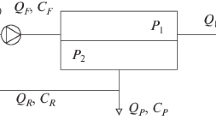Conclusion
Hypoxifiers are clinical devices producing HGM for delivering INH while providing respiratory comfort for patients. Hypoxifiers vary depending on the system of HGM production, but incorporate practically identical respiratory units for supply of the HGM to the patient.
Hypoxifiers may prepare HGM from compressed or condensed gases, or from atmospheric air.
Of the first group, the most widespread are ejection-type hypoxifiers utilizing compressed nitrogen to which atmospheric air is added at a 1:1 ratio. Since ejection-type hypoxifiers have uncomplicated design, provide operational comfort, and are reliable in producing HGM of precise and stable composition, they are the best choice where compressed nitrogen is readily available. In all other cases hypoxifiers of the second group, gas-separating membrane devices and autohypoxifiers with semiclosed circulation systems, are preferable. Less market potential of equipment of the second group results from the absence of adequate pumping devices and HGM composition control components.
Practical experience of the use of hypoxifiers demonstrates the need for equipment with more precise and stable HGM composition. The most competitive will be designs avoiding consumable materials and accommodating units to monitor the patient's condition.
Similar content being viewed by others
Literature cited
V. A. Berezovskii, V. Ya. Zhuravlenko, N. M. Ulanov, et al., Med. Tekh., No. 1, 40–43 (1989).
Yu. N. Karavaev, A. D. Neuimin, and S. F. Pal'guev, Refractory Electroconductive Ceramic Material, USSR author's certificate 726063, Otkrytiya, No. 13, 121 (1980).
Yu. M. Karash, R. B. Strelkov, and A. Ya. Chizhov, Intermittent Normobaric Hypoxia for Treatment, Prevention, and Rehabilitation Purposes [in Russian], Moscow (1988).
R. B. Strelkov, Yu. M. Karash, A. Ya. Chizhov, et al., A Method for Increasing the Nonspecific Resistance of Organisms Using Normobaric Hypoxic Stimulation: Technical Recommendations [in Russian], Moscow (1985).
U.S. Patent No. 4334533, Cl. A62v 7/10.
E. N. Reiderman, A. I. Trushin, L. I. Nemerovskii, et al., A Device for Respiration with Hypoxic Gas Mixtures, USSR author's certificate 1456161, Otkrytiya, No. 5, 28 (1989).
A. Ya. Chizhov, Yu. M. Karash, R. B. Strelkov, and V. G. Filimonov, Diagnostic and Therapeutic Techniques and Devices for Obstetrics and Gynecology [in Russian], Moscow (1984), pp. 129–132.
Additional information
Center for Prophylactic Hypoxia, Ministry of Health of the USSR, Moscow. Translated from Meditsinskaya Tekhnika, No. 1, pp. 3–8, January–February, 1992.
Rights and permissions
About this article
Cite this article
Nemerovskii, L.I. Design of equipment for intermittent normobaric hypoxia. Biomed Eng 26, 1–5 (1992). https://doi.org/10.1007/BF00562631
Received:
Issue Date:
DOI: https://doi.org/10.1007/BF00562631




